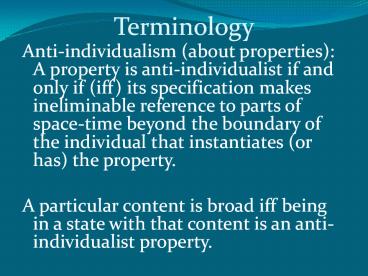Terminology PowerPoint PPT Presentation
Title: Terminology
1
Terminology
- Anti-individualism (about properties) A property
is anti-individualist if and only if (iff) its
specification makes ineliminable reference to
parts of space-time beyond the boundary of the
individual that instantiates (or has) the
property. - A particular content is broad iff being in a
state with that content is an anti-individualist
property.
2
More Terminology
- Intrinsic properties are properties preserved by
physical duplicates (on the simplifying
assumption that physical properties are
themselves intrinsic). - Supervenience The distribution of A properties
supervenes on the distribution of B properties
iff there can be no change in the dist. of A
properties without a change in the dist. of B
properties.
3
More terminology
- A-properties locally supervene on B-properties
iff there can be no change in the A-properties of
an individual without a change in B-properties of
that individual. - Narrow content is content that supervenes locally
on the intrinsic properties of the individual
subject.
4
More terminology
- Multiple realizability A property (or state, or
kind) M is multiply realizable if it can take
more than one physical form. - More technically, if and only if, there is more
than one property at a different (typically
lower) level the instantiation of which is
sufficient for somethings being M.
5
The equivalence of talk about MR and Supervenience
- Assume that A properties do not supervene on B
properties. - Then there could be a change in one of the
individuals A properties without a change in
his/her B properties. - In which case, the B properties would not realize
the A property in question. For the B properties
would not be sufficient for the instantiation of
the A property (the instantiation of the B
properties would be consistent with the presence
of more than one A property).
6
Two-factor theories
- Mental content consists of two-factors one
broad, one narrow. - Often the internal factor is take to be
conceptual or inferential role the set of
associations or inferences that a concept enters
into.
7
- Some externalist arguments are supposed to show
that the broad factor is not a function of the
narrow one. - The same narrow content is supposed to be
consistent with different broad contents,
depending on the contribution of the external
environment.
8
Concepts v. conceptions (conceptualizations)
- On Sawyers view, the concept is the shared
individual unit. - Conceptualizations are like knowledge structures
or sets of beliefs theyre constructed out of
shared concepts, and variation in these, from
subject to subject, explains the differences in
behavior from one person to the next.

